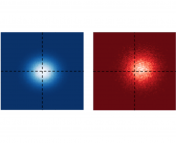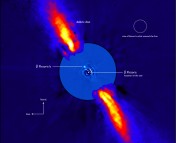Title(s): 1) Direct imaging discovery of a super-Jovian around the young Sun-like star AF Leporis, 2) AF Lep b: the lowest mass planet detected coupling astrometric and direct imaging data, and 3) Astrometric Accelerations as Dynamical Beacons: A Giant Planet Imaged Inside the Debris Disk of the Young Star AF Lep
Author(s): 1) DeRosa, J. et al. ; 2) Mesa, D. et al. ; 3) Franson, K. et al.
First Authors’ Institutions: 1) European Southern Observatory, Alonso de Córdova 3107, Vitacura, Santiago, Chile ;
2) INAF-Osservatorio Astronomico di Padova, Vicolo dell’Osservatorio 5, Padova, Italy, 35122-I ;
3) Department of Astronomy, The University of Texas at Austin, Austin, TX 78712, USA
Status: 1) Submitted to A&A, under revision [open access], 2) Accepted to A&A [open access], 3) Submitted to ApJL [open access]
Direct imaging exoplanets is difficult, but a new method of vetting targets has just helped three independent teams discover, and image, a new gas giant.
(Un)lucky Imaging
“Direct imaging” might be the most intuitive method for discovering exoplanets, but historically has been one of the most difficult in practice. Want to discover new planets? Just take a few pictures! The difficulty arises because stars are much brighter than planets, and most planets orbit relatively closely to their host stars, which are far away from us observers on Earth. Taking an image of a planet orbiting another star requires extreme angular resolution, the ability to measure high dynamic ranges, and complicated instrumental and algorithmic tools to suppress starlight.
Most directly imaged planets are young gas giant planets orbiting far away from their host stars. Their young age and high mass means these planets are hotter than their cooler, less-massive planets. They glow brighter, and their far out orbits allow them to be resolved with state-of-the-art telescopes.
For now, the largest optical telescopes are 8-10 m in diameter, and can only resolve these widely separated gas giants. This wouldn’t be a problem if there were lots of widely separated gas giants in our galaxy. Unfortunately, the process of planet formation creates very few gas giants to begin with, and even fewer gas giants at wide separations.
Historically, therefore, direct imaging has produced few detections. This is compounded because only a limited amount of telescope time per year can be dedicated to exoplanet imaging searches.
An astrometric hint
While massive exoplanets on wide orbits might be intrinsically rare, they’re still out there, as evidenced by the planets that have been found. If only astronomers knew where to look, there would probably be more known directly imaged systems.
When massive astrometric surveys, like Gaia (or the previous Hipparchos), measure the positions in time of hundreds of thousands of stars in the galaxy, these minimal changes in position can be observed. Giant exoplanets are massive enough that their gravitational pull on their host star can move the host. Over small periods of time, stars travel in roughly straight lines, so if a star is moving along a curved path, it might be due to a hidden planet or binary companion. Now, our astrometric observations have become precise enough to measure these curved paths.
The only catch is that (for now) these astrometric measurements aren’t enough to detect new planets on their own. The trouble is that a small tug can be caused by a close in planet, or a far away binary star. Existing astrometric surveys have yet to observe for long enough, at high enough precision, to measure a complete orbit of many planets. It has been claimed that in newer data releases from the Gaia mission, hundreds or thousands of exoplanet detections will be published, but so far, only one example has been shown. If you see an astrometric tug, though, you might be able to directly image the planet causing it instead, and detect and confirm the planet that way.
This method has already helped multiple teams of astronomers across the world to discover new low mass binary stars and brown dwarfs. Until now, however, all of the objects discovered by pairing absolute astrometric deflections and direct imaging have had masses above the “deuterium burning limit” (about 13x the mass of Jupiter), which is the most commonly accepted definition of the upper limit on mass for a planet.
Today’s authors (three separate teams) noticed this gravitational “tug” deflecting the path of a bright, young star AF Leporis, and decided to investigate it further.
AF Lep b

Three different, independent teams discovered a planet orbiting the accelerating star AF Lep. The wonderful thing is, each team used a slightly different method to confirm the detection, and each detected the planet at high confidence. Two teams used the SPHERE instrument on the Very Large Telescope (VLT), but in different observing configurations. Another team used the NIRC2 instrument on the W.M. Keck telescope, but observed in a different wavelength range than the other teams. This is proof that looking for planets around weirdly moving stars can yield new detections!
One paper (accepted for publication), led by Mesa et al., used the SPHERE instrument and a technique called angular differential imaging (ADI) over two nights to confirm that a planet was causing the astrometric acceleration. Their observations produced a spectrum of the planet in the Y, J, and H–bands, and photometric measurements in the K-band; they used these observations to claim that the planet has a temperature of about 1300K.
Another paper (in review, awaiting acceptance for publication), led by DeRosa et al., used the same SPHERE instrument, but a different technique. They observed in “star-hopping mode,” rapidly moving between AF Lep and a reference star every few minutes. By subtracting images of the reference star from images of AF Lep, they were able to remove the starlight and reveal the planet. Their observations yielded a similar spectrum and photometry to that presented in Mesa et al.
The third and final paper (submitted for review), led by Franson et al., used a special coronagraph on the W. M. Keck Telescope to detect the planet at a longer wavelength of light, the L’ filter, in the L-band. They used a Vector Vortex Coronagraph, a fancy piece of optics that twists light in a corkscrew to destructively interfere the light from the host star at the center of the image. They detected the planet in two observations, separated by about two years, demonstrating that the planet moves on an elliptical orbit.
Notably all three teams fit orbits to their limited measurements, and all disagree on the Kkeplerian mass of the planet. The “true mass” will likely require more observations of the planet’s orbit, as well as a combination of the existing independent datasets.
Taken together, these papers demonstrate that astrometric accelerations are powerful hints left by massive surveys like Hipparchos and Gaia that will likely reveal even more new and exciting planets in the near future.
Astrobite edited by Lina Kimmig
Featured image credit: ESO/Mesa, De Rosa et al.




